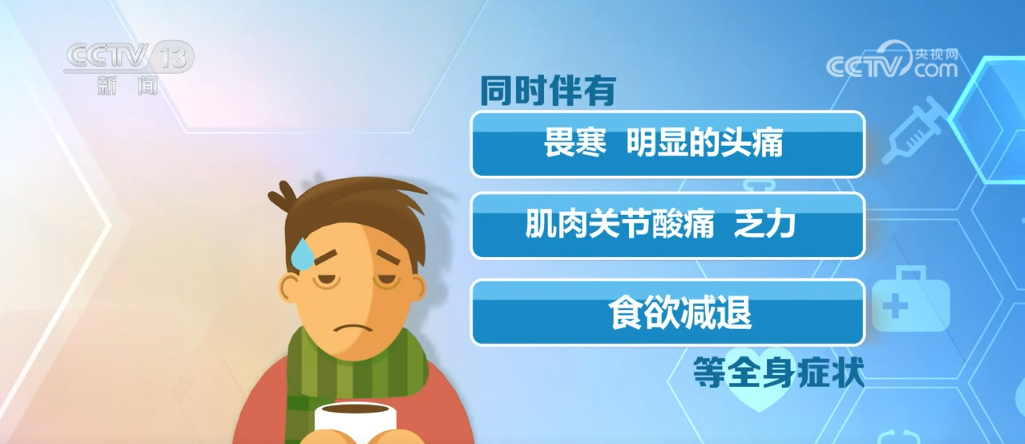Forward to understand! There is a high incidence of influenza, and all your concerns are here →
CCTV News:Recently, influenza is in a seasonal epidemic period. Then, what is the current and future epidemic situation of respiratory infectious diseases in China? What should I do if I get respiratory infectious diseases? In view of the public concern about the hot issues of respiratory disease prevention and treatment, let’s understand them one by one.

According to the influenza surveillance data released by the China Center for Disease Control and Prevention, at present, more than 99% of the influenza detected in the northern and southern provinces are H1N1. Then, let’s first take a look at the current highest incidence of swine flu.
Question: What is H1N1?
Influenza viruses are divided into four types: A, B, C and D. Influenza A, which appears most frequently recently, is highly contagious and easily spreads among people, resulting in a cluster epidemic. Influenza virus is easy to mutate and cause a wide range of epidemic. Although influenza A and common cold are both respiratory infectious diseases, their symptoms are quite different.


The typical symptom of swine flu is sudden high fever. Generally, the body temperature can reach 39-mdash on the second or third day after symptoms appear. 40℃, accompanied by chills, obvious headache, muscle and joint pain, fatigue, loss of appetite and other systemic symptoms, but also cough, sore throat, stuffy nose, runny nose and other respiratory symptoms. For children, the symptoms may be different from those of adults.
Five types of high-risk groups are easy to develop into severe cases.
Experts say that H1N1 is a self-limiting disease, and most people can heal themselves in about 7 days, but it is easy to cause complications for some people, such as bacterial pneumonia, necrotizing encephalopathy and myocarditis.

According to the influenza diagnosis and treatment plan issued by the National Health and Wellness Commission, five types of high-risk groups are very easy to develop into severe cases, so we should attach great importance to it and detect and treat it as soon as possible. These five groups of people include:
Children under 5 years old (children under 2 years old are more likely to have serious complications);
Age ≥ 65-year-old people;
Accompanied by the following diseases or conditions: chronic respiratory diseases, cardiovascular diseases (except hypertension), nephropathy, liver diseases, blood system diseases, nervous system and neuromuscular diseases, metabolic and endocrine system diseases, malignant tumors, immunosuppression, etc.
Obese (BMI greater than 30);
Pregnant and perinatal women.
How to use the medicine when the flu is "recruited"?
According to experts, once symptoms such as upper respiratory tract infection and fever appear, you should grasp the gold for 48 hours, check yourself in time or go to the hospital for treatment. With the increasing number of people infected with influenza, how to take anti-influenza drugs oseltamivir and mabaloxavir has also attracted much attention.
Li Dong, chief physician of Beijing You ‘an Hospital, once said that the advantage of mabaloxavir is that it only needs to be used once, while oseltamivir needs to be taken twice a day for five days. In addition, mabaloxavir is approved by the state for people aged 5 and over. Because its effectiveness and safety have been verified for many years, oseltamivir can be used for children over 1 year old, even under special circumstances, if doctors think that the risk of influenza is high, they can also use oseltamivir.

No matter what choice you make, the doctor suggests that both of them are prescription drugs and must be used under the guidance of a doctor or pharmacist. Many people regard oseltamivir as a "specific drug" against influenza A and B viruses, but some people are worried that if oseltamivir is eaten too much, it will lead to drug resistance.
Question: Will oseltamivir be resistant?
Director Li Dongzeng said that no obvious drug resistance has been detected at present, but it is still necessary to emphasize rational drug use and not to stop drug blindly and prematurely. Because some people may feel that their symptoms have eased after using it for a day or two, they stop taking the medicine. If they stop taking the medicine too early, the virus in their bodies may not be removed, and drug resistance will easily occur at this time, so it must be enough for routine use for 5 days.
Why should children use antitussive drugs with caution?
Cough is a common manifestation of respiratory tract infection. The National Health and Wellness Committee introduced at a recent press conference that children should use antitussive drugs with caution, and many people have some doubts about this. Why should children use antitussive drugs with caution?

Xu Baoping, chief physician of Beijing Children’s Hospital affiliated to Capital Medical University, said that cough is actually a normal physiological reflex, and its main purpose is to help expel sputum and pathogenic microorganisms secreted in the airway. However, antitussive drugs inhibit cough, which is not conducive to the discharge of sputum. However, careful use does not mean that it must not be used. If the child has a particularly severe dry cough, it can be used for a short time. As the course of the disease progresses, he may soon become coughing with phlegm. At this time, it is necessary to change the medicine in time and replace the antitussive drugs with expectorants.

Experts say that if children have the flu, using antitussive drugs may cover up some symptoms and even induce some other diseases. Even if you choose to use antitussive drugs, try to choose non-dependent drugs and take them according to your doctor’s advice.
Can you take a bath after suffering from swine flu?
Recently, the topic of "A woman with H1N1 flu can’t move her hands and feet after taking a bath for 4 days" rushed to the online hot search, which triggered netizens’ attention and heated discussion. So can you take a bath after suffering from swine flu?
Zhou Qingtao, deputy director of the Department of Respiratory and Critical Care Medicine of Peking University Third Hospital and director of the Department of Critical Care Medicine, said that generally speaking, if the fever of H1N1 has gone down or the condition has improved, you can take a bath, pay attention to the appropriate water temperature, dry your body in time after bathing, and pay attention to keeping warm so as not to aggravate the condition. Bathing is not recommended for those patients who are suffering from fever or serious illness, which may lead to aggravation and even danger.